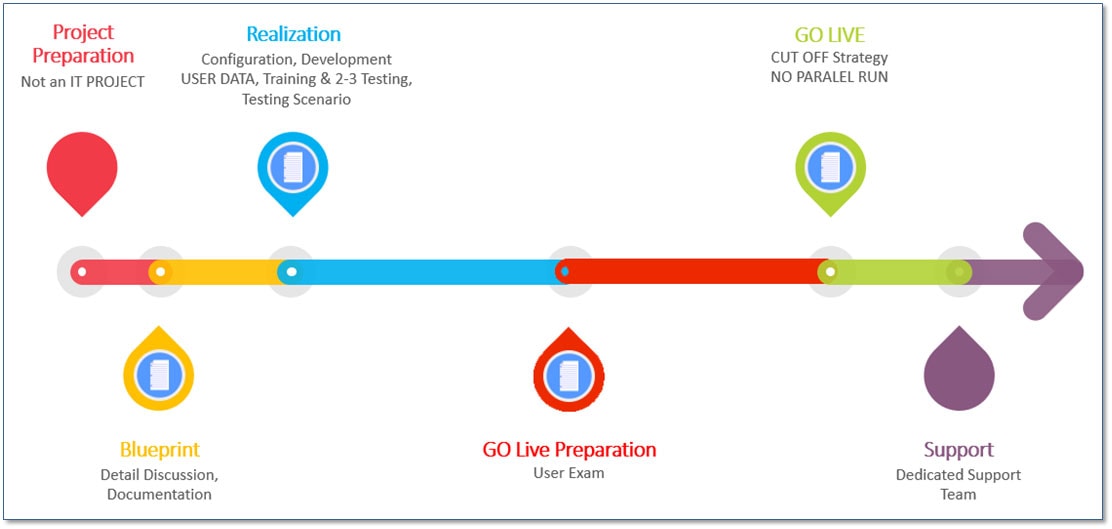We can test the readiness of the ERP system and data during training and especially testing, but the last question is whether our prospective users are ready or not?
Generally, not all potential users are involved in ERP implementation projects. For example, when your company wants to use SAP Business One, you have 100 potential new users, but maybe only about 20 people will be involved in the organization and activities of the SAP Business One implementation project.
Thus, the 20 people involved will become your expert users and the rest will be casual users.
Your expert users may be ready to use the new ERP system, because they are involved for 3 or maybe 6 months or years, but other potential users are not directly involved.
How can we be sure they understand and can run the new system properly from the first day? User readiness is one of the keys to a successful ERP system implementation.
TIPS:
Use the “Train the Trainer” (TTT) method, where your prospective expert users train the rest of the other potential users.
This way we can validate whether our expert team is ready. This will also help you so that when the system is running you don’t depend on a consultant or anyone else to help you.
How to convince 80 of your potential users if they only pass the training stage?
We continue to observe and think about this, and it is difficult to assess whether the prospective user is ready to use the new system or should we postpone the use of the new system because it turns out that the prospective user is not ready?
In general, prospective users will say WE ARE READY, during meetings before the management decide to keep going on schedule or postpone due to user readiness.
Based on our experience, prospective users who claim to be ready when they start using the system, constantly need guidance even for simple things.
It turns out that from observations during the ERP implementation process so far, we find that prospective users feel ready because there are still consultants, who usually standby at the early days when the system used.
Of course this is not what we want. Imagine if you have 100 users in 10 branches, do we have to prepare 10 people to accompany users when the new system is used? That will be very inefficient.
TIPS:
After learning this, we tried ways to measure the readiness of potential users with numbers, so as to avoid making mistakes.
So now, every time after prospective user conducting training, we will test it in the form of questions regarding matters related to the new system and new SOPs.
Thus, we have data on the readiness of potential users better, so that the decision to keep running the new system or delay becomes more measurable.
By delaying due to user readiness, we can use the time again to re-train and test again.
Thus, when the new system starts running, everything is in place, whether the system itself, SOP, data, and user readiness.
Of course, the 8 tips that we are trying to share cannot guarantee that the MIS / IT system replacement project, especially your ERP system, will immediately succeed, but at least they can make you have more consideration and attention to the project.
We also don’t try to simplify the implementation of an ERP system with just these 8 tips, considering the size of the company, the complexity of the business processes, the number of users and not to mention that the culture of each company is very different from one another.
There are companies that are very adaptable to change, but also many that need a lot of time and energy to make a change.
Finally, there is one question that always annoys us as consultants who help implement ERP systems.
Why is there a company that can implement an ERP system well and be categorized as successful according to the Chaos Report, but other companies of the same type, having the exact same industry and using the same ERP end up failing. Can not use the newly implemented system at all.
We think that corporate culture ultimately plays an important role in the success or failure of system implementation, one of which is how to handle change (change management) that occurs when the project is running and the new system is used.
Of course there are other factors such as the role of those who help such as consultants which are no less important.
Not all consultants are suitable for all companies, like us PT. Sterling Tulus Cemerlang (www.sterling-team.com) currently does not understand the banking industry.
If we are entrusted with handling the replacement of the banking system, the probability of failure will be higher than a team of consultants who are focused and experienced in the banking industry.
7 other key points that influence the success of ERP system implementation:



